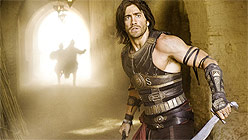For millennia, the West has accepted the ancient Greeks as exemplars and their Persian rivals as barbarians. As 300 demonstrated, the version of their story handed down by the Greek historian Herodotus still rules.
Comes now the Pirates of the Caribbean team of Walt Disney Pictures and producer Jerry Bruckheimer, who clearly aren’t cowed by 2,500 years of pro-Greek tilt. They’ve made a film about a swashbuckling Persian hero, derived from a source somewhat less venerable than Herodotus: a video game that dates to 1989.
Prince of Persia: The Sands of Time isn’t all video-game action. It also features smatterings of history, British stage veterans and imposing scenery — though it’s Morocco, not Iran. Still, the movie might as well be set in Narnia.
Our hero is Dastan, a name the film implicitly links to the word “destiny.” He’s introduced as an orphan scamp, evading soldiers by bounding through the local bazaar. King Sharaman (Ronald Pickup) is so impressed by the boy’s simian dexterity that he adopts him, making him equal with his sons.
Dastan grows into a man, played by a beefed-up, often shirtless Jake Gyllenhaal. Along with the muscles, the actor has also grown an English accent, which is passable but clashes with his aw-shucks American demeanor.


